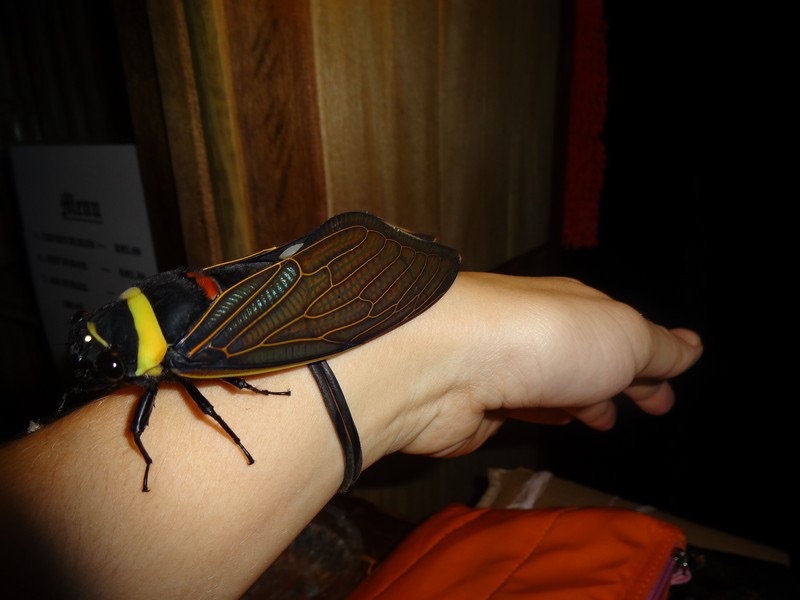Predator satiation survival strategy
The nymphs emerge in large numbers about the same time, sometimes more than 1.5 million individuals per
acre (>370/m2).
[18] Their mass emergence is a survival trait called
predator satiation: for the first week after emergence, the periodical cicadas are an easy prey for
reptiles,
birds,
squirrels,
cats, and other small and large
mammals.
[5][19] Early ideas maintained that the cicadas' overall survival mechanism was simply to overwhelm predators by their sheer numbers, ensuring the survival of most of the individuals. The emergence period of large
prime numbers (13 and 17 years) was additionally hypothesized to be a predator avoidance strategy adopted to eliminate the possibility of potential predators receiving periodic population boosts by synchronizing their own generations to
divisors of the cicada emergence period.
On this hypothesis a predator with a three-year reproductive cycle, which happened to coincide with a brood emergence in a given year, will have gone through either four cycles plus one year (12 + 1) or five cycles plus two years (15 + 2) by the next time that brood emerges. In this way prime-numbered broods exhibit a strategy to ensure that they nearly always emerge when some portion of the predators they will confront are sexually immature and therefore incapable of taking maximum advantage of the momentarily limitless food supply.
[20]
Another viewpoint turns this hypothesis back onto the cicada broods themselves. It posits that the prime-numbered developmental times represent an adaptation to prevent hybridization
between broods. This unusual method of sequestering different populations arose, it is hypothesized, when conditions were extremely harsh. Under those conditions the mutation producing extremely long development times became so valuable that cicadas which possessed it found it beneficial to protect themselves from mating with cicadas lacking the long-development trait. In this way, the long-developing cicadas retained a trait allowing them to survive the period of heavy selection pressure (i.e., harsh conditions) brought on by isolated and lowered populations during the period immediately following the retreat of glaciers (in the case of periodic cicadas, the
Pleistocene glacial stadia). When seen in this light, the cicada's predator satiation strategy serves only to maintain the much longer-term survival strategy of protecting their long-development trait from hybridizations that might dilute it.
[21]
This hybridization hypothesis was subsequently supported through a series of mathematical models and remains the most widely-accepted explanation for the unusually lengthy and mathematically sophisticated survival strategy of these insects.
[22] The length of the cycle was hypothesized to be controlled by a single gene locus, with the 13-year cycle dominant to the 17-year one,
[23] but this interpretation remains controversial and unsubstantiated at the level of DNA.
Broods[edit]
Periodical cicadas are grouped into geographic
broods based on the calendar year when they emerge. For example, in 2014, the 13-year brood XXII emerged in Louisiana and the 17-year brood III emerged in western Illinois and eastern Iowa.
In 1898,
entomologist C. L. Marlatt assigned Roman numerals to 30 different broods of periodical cicadas: 17 distinct broods with a 17-year life cycle, to which he assigned brood numbers I through XVII (with emerging years 1893 through 1909); plus 13 broods with a 13-year cycle, to which he assigned brood numbers XVIII through XXX (1893 through 1905).
[26]
Many of these hypothetical 30 broods, however, have not been observed. Furthermore, two of the brood numbers assigned by Marlatt (broods XI and XXI) existed at one time, but have become extinct. The Marlatt numbering scheme has been retained for convenience (and because it clearly separates 13- and 17-year life cycles), although only 15 broods are known to survive today.
[27]
Adult periodical cicadas live only for a few weeks; by mid-July, all have died. Their brief-lived adult forms are adapted for one purpose: reproduction. The males "sing" a species-specific mating song; like other cicadas, they produce loud sounds using their tymbals. Singing males of a single
Magicicada species form aggregations (choruses) that are attractive to females. Males in these choruses alternate bouts of singing with short flights from tree to tree in search of receptive females.
[2] Most matings occur in "chorus" trees.
[6]
Receptive females respond to the calls of conspecific males with timed wing-flicks, which attract the males for mating.
[17] The sounds of a "chorus"—a group of males—can be deafening and may reach 100
dB. In addition to their "calling" or "congregating" songs, males produce a distinctive courtship song when approaching an individual female.
[6]
Both males and females can mate multiple times, although most females seem to mate only once. After mating, the female cuts V-shaped slits in the bark of young twigs and lays about 20 eggs in each, for a total clutch of 600 or more. After about 6–10 weeks, the eggs hatch and the nymphs drop to the ground, where they burrow and begin another 13- or 17-year cycle.





